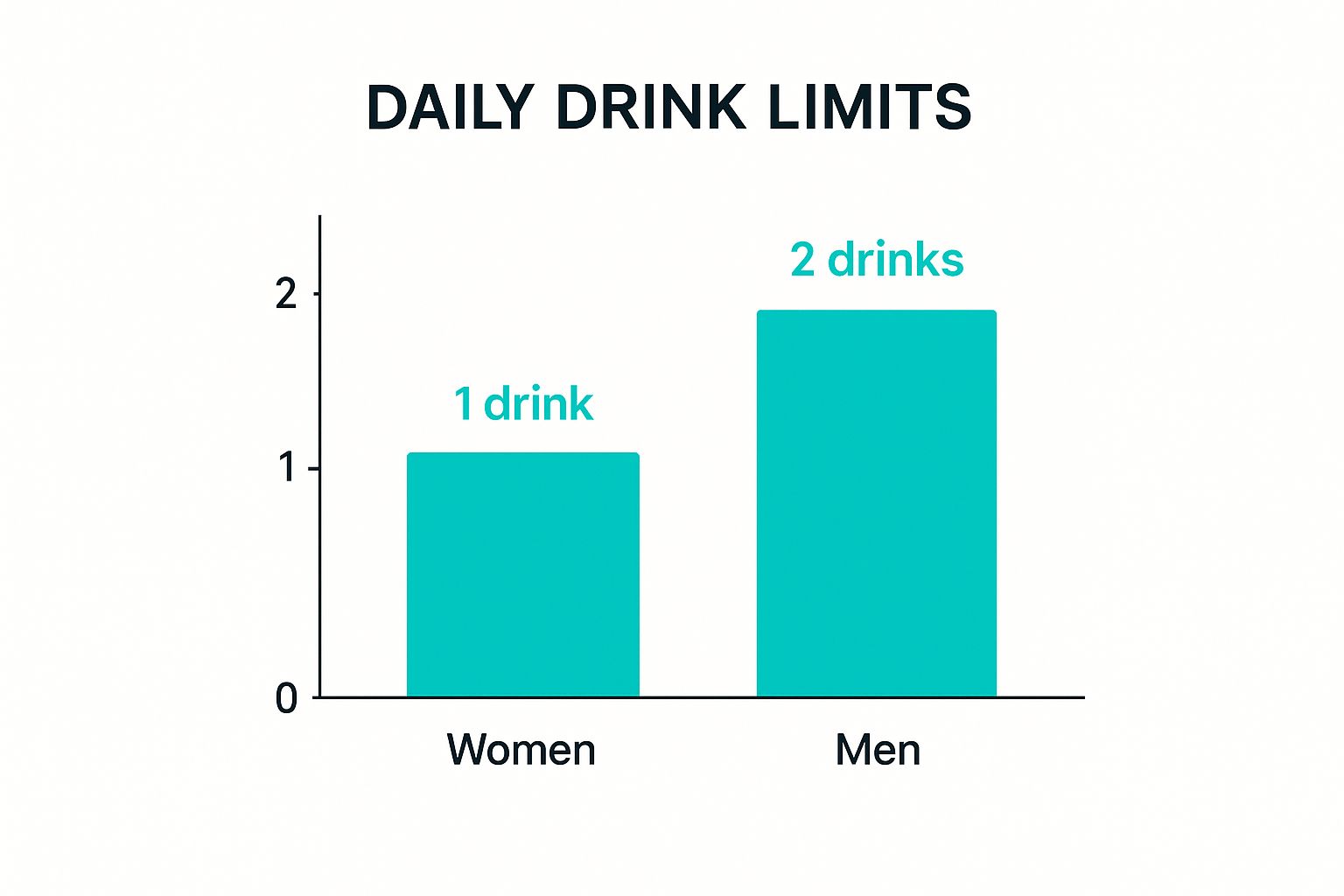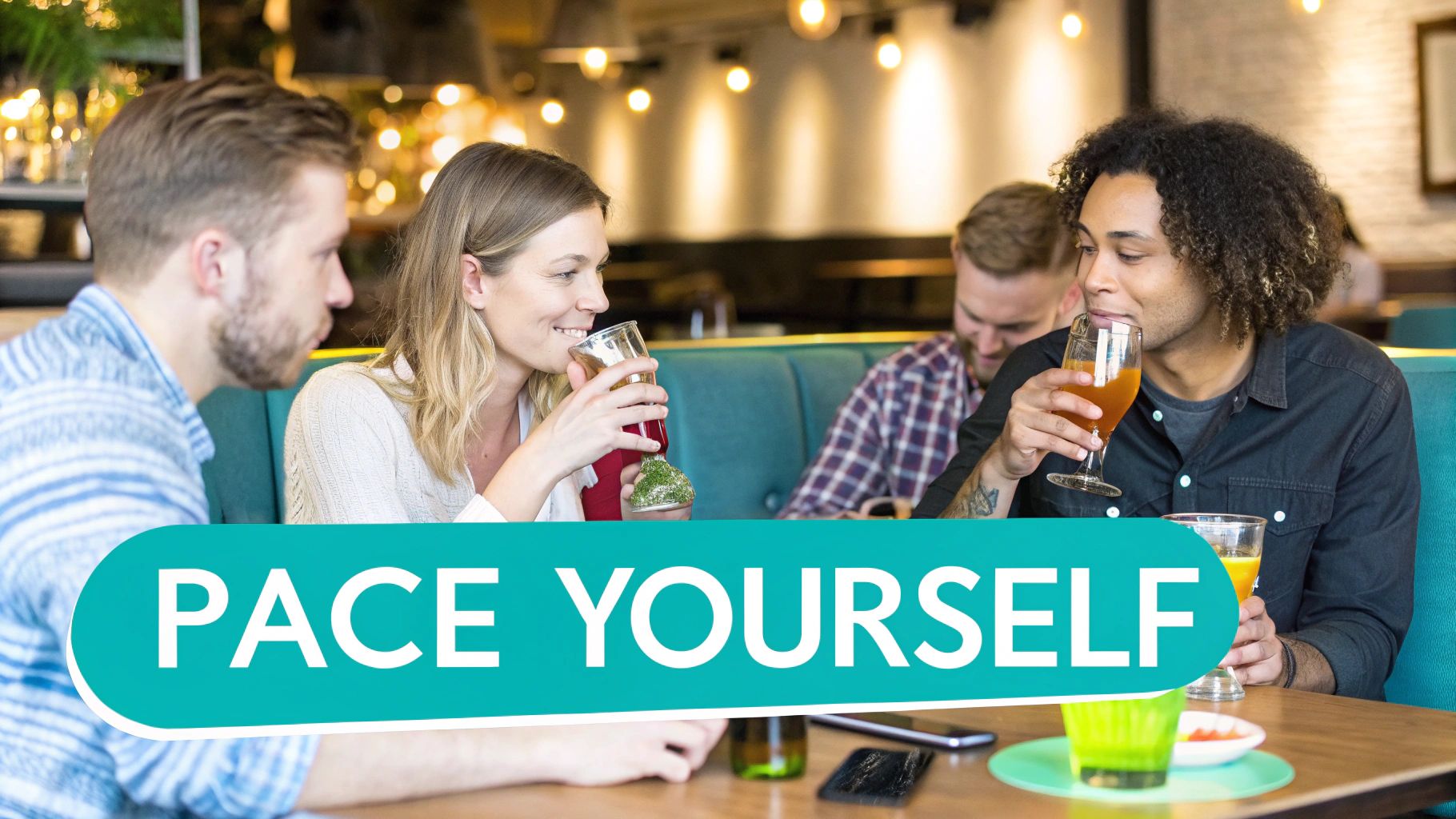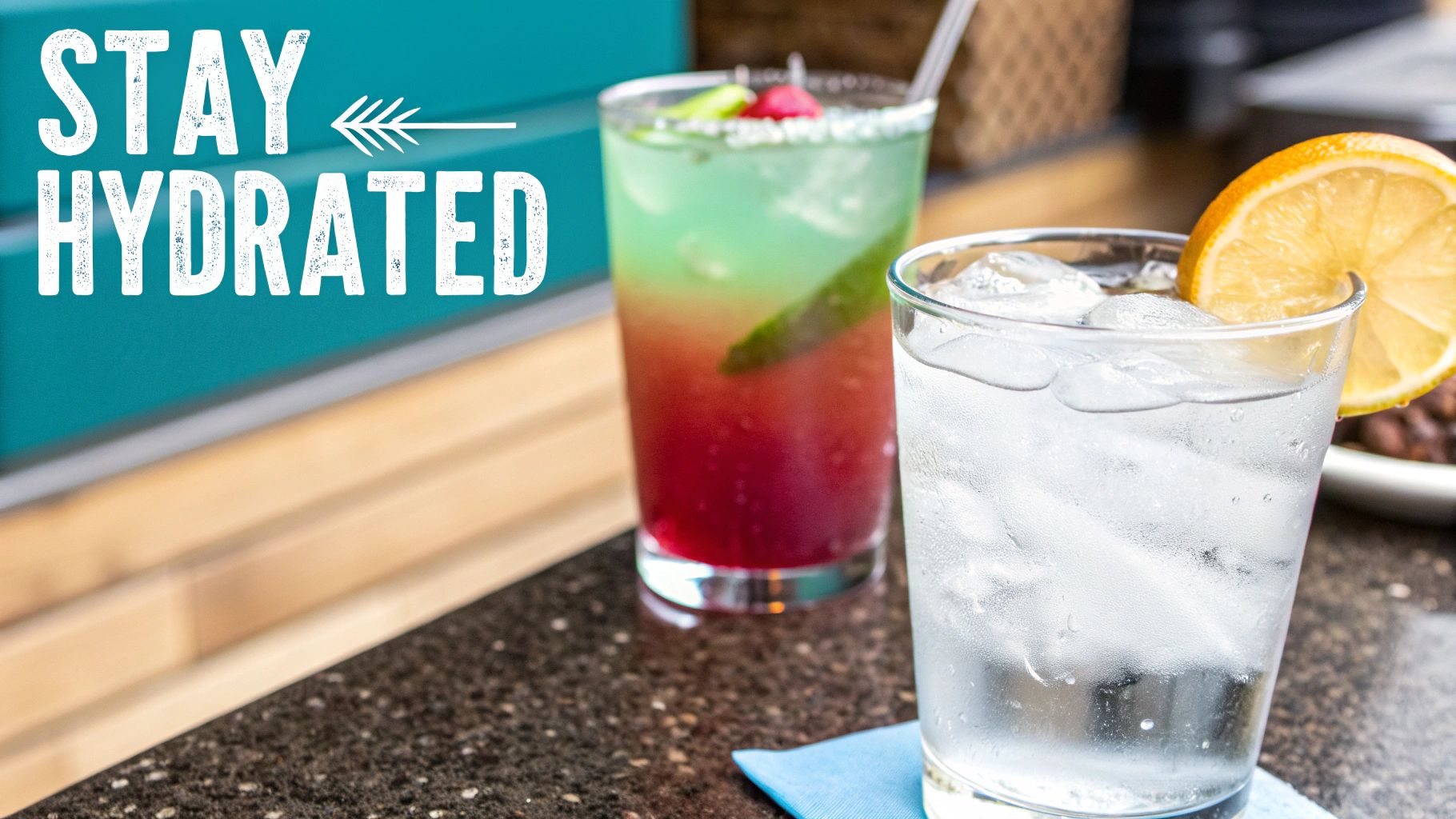

· By Annemarie
How to Drink Responsibly: Tips for Safe Enjoyment
What Responsible Drinking Actually Means Today

The infographic above gives a visual representation of recommended daily drink limits. For women, the guideline suggests a maximum of one standard drink per day, while for men, it's two. These limits offer a helpful starting point for understanding what constitutes moderate alcohol consumption. To delve deeper into the modern understanding of responsible drinking, exploring resources specifically focused on Alcohol can be very beneficial. This brings us to an important question: what exactly is a standard drink?
Defining a "Standard Drink"
A standard drink isn't just any glass of your favorite beverage. It refers to a specific amount of pure alcohol, which can vary depending on what you're drinking. Typically, a standard drink is 12 ounces of beer, 5 ounces of wine, or 1.5 ounces of distilled spirits.
This is because these servings generally contain approximately the same amount of pure alcohol – around 0.6 ounces or 14 grams. Understanding this distinction is fundamental to responsible consumption.
Understanding Moderation and Its Limits
Responsible drinking encompasses more than simply knowing the definition of a standard drink. It’s about managing your overall alcohol intake to align with recommended health guidelines. Moderate drinking, for instance, is often defined as up to one standard drink per day for women and up to two for men.
Exceeding these guidelines increases the risk of several health issues, including liver disease and cardiovascular problems. Responsible drinking also means avoiding binge drinking, usually defined as consuming five or more drinks in a single sitting. You can find more detailed information about responsible alcohol consumption.
Binge drinking dramatically elevates the risk of both immediate harm, like accidents and injuries, and long-term health consequences. It's a crucial aspect to consider when discussing responsible alcohol consumption.
Responsible Drinking in a Social Context
Applying these guidelines in real-life situations, especially social gatherings, can be challenging. This is where practical strategies become vital. One key component of responsible consumption is setting personal limits before you start drinking.
This involves deciding in advance how many drinks you’ll have and sticking to that plan. Alternating alcoholic beverages with water can also help pace your drinking and stay hydrated. These tactics contribute to physical well-being and empower you to maintain better control in social situations.
By employing these strategies, you can enjoy the social aspects of drinking without jeopardizing your health and safety. It's about finding a balance that allows for enjoyment while prioritizing responsible choices.
To illustrate global variations in drinking guidelines, let's examine the standard drink sizes and recommended weekly limits across different countries. The following table provides a comparison:
Standard Drink Guidelines Across Countries
| Country | Standard Drink Size (g of alcohol) | Weekly Limit - Men | Weekly Limit - Women |
|---|---|---|---|
| Australia | 10 | 140 | 70 |
| Canada | 13.6 | 136 | 91 |
| France | 10 | 210 | 140 |
| Germany | 10 | 140 | 70 |
| UK | 8 | 168 | 112 |
| USA | 14 | 196 | 98 |
This table highlights how different cultures approach alcohol consumption guidelines. The standard drink size, as well as weekly recommended limits, can vary significantly. This underscores the importance of being aware of local guidelines when traveling or interacting with individuals from different backgrounds. It’s a fascinating look at how cultural norms and health recommendations intersect.
Practical Tracking Techniques That Actually Work
Keeping tabs on your alcohol intake is key to responsible drinking. But it shouldn't feel like a chore. This section explores proven tracking methods that fit easily into your social life, so you can enjoy yourself and stay in control.
Simple Counting Systems for Keeping Tabs
One of the easiest techniques is a drink counting system. Before you start drinking, set a reasonable limit based on your personal tolerance and the occasion. As the evening progresses, consciously track each drink you have. This awareness alone can encourage more mindful drinking.
For a more hands-on approach, try using physical counters like beads or coins. Moving an object from one pocket to another for each drink gives you a tangible reminder of your consumption. This physical action reinforces the mental tracking, making it less likely you’ll lose count.
Leveraging Technology to Aid Your Efforts
Technology provides convenient and discreet ways to monitor your alcohol consumption. Several tracking apps are designed specifically for this purpose.
These apps often provide features such as:
- Logging each drink quickly and easily.
- Setting personalized limits and getting notifications.
- Visualizing your drinking patterns over time.
With so many options available, choose an app that fits your individual needs and preferences.
The Power of Pacing and Alternating Drinks
Pacing your drinks is a very effective strategy for responsible consumption. This means consciously slowing down your drinking rate. A practical method is to alternate alcoholic beverages with water.
This simple tactic not only keeps you hydrated, which is crucial for your well-being, but it also puts more time between alcoholic drinks. This allows your body to process the alcohol more effectively.
Navigating Social Dynamics with Confidence
Social situations can often be the most challenging for responsible drinking. But with the right strategies, you can confidently stick to your limits while still enjoying social connections. Developing pre-planned responses for declining drinks can be extremely helpful. Here are a few examples:
- "I'm pacing myself tonight, but thanks for the offer."
- "I'm good for now, but maybe later."
- "I'm actually switching to water now."
These simple phrases provide polite yet firm ways to say no without feeling pressured. Remember, responsible drinking is a personal choice, and you have the right to set your own boundaries. By combining practical tracking techniques with confident communication, you can enjoy social events while staying in control of your alcohol intake. This allows you to prioritize your well-being without giving up social enjoyment. Upside Hangover Sticks can further enhance your strategy by helping you minimize the after-effects if you choose to indulge, allowing you to live more without the burden of a hangover.
Beyond Beer: The New World of No-Alcohol Options

The social drinking scene is evolving, with no-alcohol options taking center stage. This shift provides a fresh perspective on responsible drinking, offering flavorful alternatives to traditional alcoholic beverages. These drinks aren't just for designated drivers anymore; they're a conscious choice for anyone looking to moderate their alcohol intake without skipping the social fun.
The Rise of No and Low-Alcohol Beverages
The demand for no and low-alcohol beverages is exploding. This isn't a passing fad; it reflects a larger movement towards healthier living and mindful drinking. The market is set for significant growth, offering more choices for those who want to drink responsibly. For instance, the no-alcohol sector is expected to see a 7% compound annual growth rate (CAGR) from 2024 to 2028, adding over $4 billion in market value.
This trend aligns with the growing interest in mindful drinking among younger generations, especially Millennials and Gen Z. These generations are increasingly participating in events like Dry January and Sober October. The rise of no-alcohol options empowers people to manage their alcohol consumption while still enjoying social gatherings. Find more detailed statistics here.
Crafting Flavor Without the Alcohol
Creating appealing no-alcohol drinks presents a unique challenge for brewers and beverage makers. Replicating the complex flavors and satisfying mouthfeel of alcoholic beverages without the alcohol itself takes skill. Master brewers are using innovative techniques, incorporating unique ingredients and specialized brewing methods to achieve remarkable results.
This innovation has resulted in a diverse range of no-alcohol beers, wines, and spirits that stand on their own. These aren't mere imitations; they are carefully crafted beverages designed for a discerning palate, offering a satisfying experience that goes beyond simply abstaining from alcohol.
Integrating No-Alcohol Options Into Your Social Life
Smartly incorporating no-alcohol options into your drinking habits is crucial for responsible drinking. Consider starting your evening with a no-alcohol beer or cocktail. This lets you enjoy the social atmosphere without immediately consuming alcohol.
Alternating between alcoholic and non-alcoholic drinks throughout the night is another effective strategy. This helps you pace yourself, stay hydrated, and ultimately drink less alcohol overall. Socializing shouldn't revolve solely around alcohol.
No-alcohol options offer a way to actively participate in social events while managing your alcohol intake and prioritizing your health. They allow you to stay connected and enjoy the company of others without compromising your well-being. This fosters a more balanced and sustainable approach to socializing, where enjoyment and responsibility go hand-in-hand.
The following table offers a quick comparison of some popular non-alcoholic alternatives currently available:
Comparison of Popular Non-Alcoholic Alternatives This table evaluates leading non-alcoholic beverages across taste similarity to alcoholic counterparts, availability, price point, and consumer satisfaction ratings.
| Product Category | Taste Similarity | Availability | Average Price | Consumer Rating |
|---|---|---|---|---|
| Non-Alcoholic Beer | High | Widely Available | $10-15 per six-pack | 4/5 |
| Non-Alcoholic Wine | Medium | Increasingly Available | $15-25 per bottle | 3.5/5 |
| Non-Alcoholic Spirits | Varies | Growing Availability | $25-40 per bottle | 4/5 |
| Mocktails | High (depending on recipe) | Widely Available (ingredients readily accessible) | Varies depending on ingredients | 4.5/5 |
As you can see, there are many options available at various price points and with varying levels of consumer satisfaction. It's worth trying a few different brands and types to find what best suits your taste.
The Economics of Smarter Drinking Choices

Understanding the financial aspects of drinking can significantly influence our alcohol choices. This section explores how economic factors affect both what the alcohol industry offers and how consumers behave, ultimately impacting responsible drinking habits.
How Income Affects Drinking Habits
Global income changes directly influence the alcohol market. As disposable incomes increase, especially in developing economies, people often purchase more premium and craft alcoholic beverages. This creates a demand for higher-quality, and often pricier, drinks.
However, this economic shift also coincides with growing awareness of responsible consumption. Increased disposable income doesn't simply mean more expensive drinks. It also provides access to resources and information about healthier drinking habits. This fuels a market for products supporting moderation.
The Role of Pricing and Digitalization
Pricing strategies within the alcohol industry significantly shape consumer behavior. For instance, the increased availability and often lower cost of non-alcoholic alternatives makes responsible choices more accessible.
Moreover, the growth of e-commerce has changed how people purchase alcohol. Online platforms offer convenience and broader selections, including low and no-alcohol options. This accessibility simplifies exploring and choosing drinks aligned with moderation goals. These market trends demonstrate how economic factors can actively support responsible drinking. Find more detailed statistics about the growing alcohol market here.
Economic Incentives and Health Outcomes
A compelling relationship exists between economic incentives and public health concerning alcohol. Governments can implement policies, such as taxes on alcoholic beverages, to deter excessive consumption.
These economic measures can fund public health initiatives, including alcohol awareness and treatment programs. This approach combines financial incentives with health-focused strategies to promote responsible drinking more broadly, highlighting how economic policies can contribute to positive health outcomes.
Navigating the Modern Alcohol Marketplace
Today’s alcohol marketplace increasingly encourages responsible choices. Consumers encounter a wider range of options than ever, from premium craft beers to sophisticated non-alcoholic spirits.
This diverse market empowers informed decisions about drinking habits. Understanding the relevant economic factors provides valuable context for navigating this landscape and choosing drinks that align with personal preferences and responsible consumption goals. This knowledge allows enjoyment of the social and personal aspects of drinking while prioritizing health and well-being. By understanding these connections, consumers are better equipped to make smart drinking choices that benefit both their wallets and their health.
Mastering Social Situations While Staying in Control
Navigating social events that involve alcohol can be tricky when you're focused on drinking responsibly. This section offers practical strategies to help you maintain your limits while still enjoying social connections. It's all about finding a balance that allows you to participate fully without compromising your responsible drinking goals.
Setting Boundaries Without Awkwardness
Effective communication is key to setting boundaries around alcohol. You don't have to announce your drinking limits to everyone, but having a few polite yet firm responses ready can help deflect unwanted pressure.
- "I'm pacing myself tonight, but thanks for the offer!"
- "I'm switching to water for now."
- "I'm good for now, I've reached my limit for the night."
These simple responses clearly communicate your boundaries without making the situation uncomfortable. Remember, being assertive about your choices is a vital part of responsible drinking.
Handling Persistent Offers and Supporting Others
Sometimes, you might encounter persistent offers even after declining a drink. In these situations, reiterating your initial response firmly and politely is usually enough. For example, you could say, "I appreciate the offer, but I'm really trying to stick to my limit tonight."
Supporting others in their moderation efforts can also make social situations more comfortable for everyone. If you see a friend struggling to stay within their limits, offering a non-alcoholic drink or suggesting a different activity can be a subtle yet helpful way to support them.
Navigating Different Social Contexts
Different social settings call for different approaches to responsible drinking. At a workplace function, for instance, it’s particularly important to maintain professional behavior while still enjoying the event. Sticking to your pre-determined limit and pacing yourself throughout the evening is key.
Family gatherings can present unique challenges, especially if drinking is a significant part of the family culture. Openly communicating your decision to drink responsibly can help set expectations and avoid potential pressure. Consider bringing your own non-alcoholic beverages to ensure you have plenty of options.
Practical Approaches for Group Responsibility
Planning ahead can significantly impact your ability to stay in control during social events. If you're going out with a group, consider designating a driver beforehand. This ensures everyone gets home safely and eliminates the temptation to drive after drinking.
Having a transportation plan, whether it's a rideshare service like Uber, public transport, or a designated driver, is always a smart move. Knowing you have a safe way home can alleviate the pressure to drink excessively. Using Upside Hangover Sticks can also be part of your responsible drinking strategy. They can help minimize potential after-effects if you do choose to have a few drinks, allowing you to enjoy social situations without worrying about the next morning. Remember, responsible drinking is about making choices that protect your well-being while still allowing you to enjoy social experiences. By using these strategies, you can maintain control and build positive social connections.
The Real Health Benefits of Drinking Responsibly
Understanding how alcohol affects your body is key to making informed decisions about your drinking habits. This goes beyond simply avoiding a hangover; it's about prioritizing your long-term health and well-being. Let's delve into the specific ways moderate drinking impacts your physical and mental health, compared to excessive alcohol consumption.
Alcohol's Impact on Key Bodily Systems
Alcohol interacts with various bodily systems. Moderate drinking, as defined by established guidelines, may have some positive associations with cardiovascular health in certain individuals. However, these potential benefits are easily overshadowed by the risks of excessive drinking. Excessive alcohol use is linked to an increased risk of heart disease, stroke, and high blood pressure.
Beyond the cardiovascular system, alcohol significantly impacts sleep. While a nightcap might seem relaxing, it can disrupt sleep patterns and lead to poorer sleep quality. This effect becomes more pronounced with increased alcohol intake. Responsible drinking means considering these impacts and making mindful choices.
The Science of Alcohol Metabolism
Your body processes alcohol through a complex metabolic pathway, primarily occurring in the liver. The rate of metabolism varies based on several factors, including genetics, age, sex, and overall health. Understanding this process is crucial for making responsible decisions about alcohol consumption.
For example, women generally metabolize alcohol slower than men due to differences in enzyme activity and body composition. This means that the same amount of alcohol can have a more potent effect on women. Similarly, age-related changes in liver function can influence how your body processes alcohol. Being mindful of these individual variations helps personalize your approach to responsible drinking.
How Drinking Affects Different Demographics
Alcohol's effects can differ significantly across various demographics. Age is a key factor, as older adults may be more susceptible to alcohol's adverse health effects due to age-related changes in body composition and metabolism. Genetic predispositions also play a role in how individuals process alcohol, influencing both tolerance and potential health risks.
If you struggle to maintain control in social settings, exploring strategies for coping with social anxiety might be helpful. Responsible drinking isn't a one-size-fits-all approach; it's about understanding your individual needs and limitations. By acknowledging these demographic variations, you can make informed choices about your drinking habits.
Developing strategies that support your overall health is crucial. Remember, responsible consumption is about making choices that align with your personal well-being. This involves understanding how alcohol affects you and using that knowledge to inform your decisions. Prioritizing your health and making informed choices about alcohol consumption ultimately contributes to a healthier and more fulfilling lifestyle. Using a product like Upside Hangover Sticks can be part of a responsible approach, helping minimize after-effects if you choose to indulge. This empowers you to enjoy social occasions without the worry of a hangover, making responsible drinking more sustainable and enjoyable.
Creating Your Personalized Responsible Drinking Plan

Responsible drinking looks different for everyone. It’s a personal journey, not a one-size-fits-all solution. This section will help you create a personalized plan that works for your life, preferences, and goals. This approach is far more effective than trying to stick to rigid rules that just don't fit your lifestyle.
Identifying Your Triggers and Risk Factors
The first step is understanding your own relationship with alcohol. Think about situations or emotions that might lead you to drink more than you planned.
These triggers could be anything from social pressure and stress to specific environments. Knowing your triggers allows you to anticipate potential challenges and develop coping strategies.
It's also important to honestly assess your risk factors. This includes things like a family history of alcohol problems, any personal health conditions, or past experiences with excessive drinking. This honest self-assessment is crucial for building a solid plan.
Setting Meaningful Personal Limits
Once you understand your triggers and risk factors, you can set realistic drinking limits. These limits might differ from general recommendations, and that's perfectly fine. The most important thing is that your boundaries support your well-being.
This might mean setting a maximum number of drinks for certain occasions or choosing not to drink at all on some days. Your plan should empower you to make healthy choices that align with your individual needs.
Implementing Your Tracking Method and Evaluating Progress
Pick a tracking method that works for you. It could be as simple as counting your drinks, using a mobile app, or keeping a journal. Tracking your intake provides valuable insights into your habits and keeps you accountable.
Regularly review your progress. Ask yourself: Are you staying within your limits? Are there certain situations where it's more difficult? Honest reflection will help you adjust your plan as needed and celebrate your wins. This ongoing process of self-monitoring and adjustment will keep your plan effective and relevant.
Building a personalized responsible drinking plan is an investment in yourself. It's about making conscious, healthy choices that support your overall happiness. This proactive approach allows you to enjoy social events while managing your alcohol consumption. For additional support, you might consider adding Upside Hangover Sticks to your routine. Learn more about Upside Hangover Sticks and how they can support your responsible drinking journey. They provide a convenient and effective way to feel your best the next day, further reinforcing positive habits.
